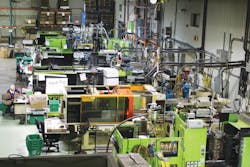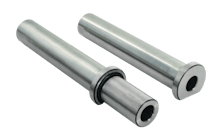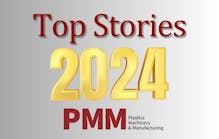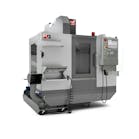Problem: Inadequate and incomplete production data hampered profitability, efficiency and growth at one custom injection molder.
Solution: An enterprise resource planning system tailored to the plastics industry provides key data that better informs pricing, purchasing and scheduling decisions.
Implementing an enterprise resource planning (ERP) system has helped custom injection molder Precimold turn unprofitable part runs into moneymakers.
Precimold, Candiac, Quebec, produces high-precision parts for the automotive, defense, medical and electronics markets. The company has 75 employees, 20 injection molding machines and 200 active product lines it molds for its customers.
The ERP system, purchased from CyFrame International Enterprises in Montreal, also helped Precimold save money on volume resin purchases, improve machine utilization, reduce back orders and decrease personnel.
“One key item the ERP gave us was a more complete picture of our business by identifying products that we were not making enough money on,” said Jack McDonald, owner and president of Precimold. “This allowed us to present our books to some customers to get small price increases. They were more willing to negotiate with us after we presented detailed information provided by the ERP.” These customers had previously refused to accept price increases without tangible proof in the form of timely ERP reports, he said. Precimold was able to get paid 5 percent to 10 percent more on what had been money-losing components.
Of course, not every customer was willing to agree to price increases.
“We make lots of automotive parts and we can’t raise prices there because we are locked into contracts,” McDonald said. Despite that, Precimold found other ways to save money.
“The ERP system gave us a better grasp on the resins we were buying, which helped us in buying volumes,” McDonald said. “By identifying our future volume needs, it allowed us to buy resin from manufacturers in larger volumes on more favorable terms or to ask for help on the resin pricing. Armed with solid information from the ERP system, we were more confident asking for extended terms or better pricing.”
The ERP system also helped Precimold reduce its costs by allowing the company to see which machines were more efficient.
“We learned that some machines run molds better than others,” McDonald said. “Going from a paper-based system to one that is based on actual production numbers helped us understand our resources and plan better. The ERP system provided better long-term visibility on our machines. It helped manage our order flow, because we knew what production we could get from each machine. The history of our machines provided by the ERP system and forecasts from our customers helped us plan production better.”
The ERP system helped Precimold reduce back orders by 80 percent, by improving machine utilization and by providing convenient access to live data that the company needed to accurately schedule production months ahead of time. Previously, Precimold used a huge production scheduling board that had space for only four weeks of scheduling and relied on information stored in several employees’ heads. The ERP system replaced that antiquated system with one based on accurate machine usage and production data.
The ERP system also allowed Precimold to reduce staffing in its office.
“We had a lot of people involved in paper analysis before we implemented the ERP system,” McDonald said. “We were able to reduce our office staff through retirements.”
Now that Precimold has a better grasp on its production costs and operations, the company is in acquisition mode. McDonald said that Precimold recently agreed to acquire Kamek Precision Tools in Baie-D’Urfé, Quebec, which will double the size of the company. Kamek is a custom injection molder that also provides product design, mold design and mold fabrication services.
“Kamek is a strong provider to the medical industry and we will be moving into a new, state-of-the-art facility,” McDonald said. “We will be consolidating their ERP system with our ERP system.”
COMPANY BACKGROUND
McDonald acquired Precimold from company founder Gunter Weiss in 2016. The deal included the sale of the 48,000-square-foot facility that Precimold now resides in. McDonald, who describes himself as an entrepreneur, said he knew that Precimold, which had been operating a pen-and-paper management system with some Excel spreadsheets and a rudimentary accounting system, needed to modernize.
Implementing the ERP system was not disruptive because the company was transitioning from a paper-based system, rather than from one ERP system to another, McDonald said.
“There was a lot of anxiety [for] some of our staff members who were apprehensive about the change. For example, they were going to be using scanning guns instead of writing in a log,” he said. “Looking back, I think part of that anxiety was a failure on my part in communicating all the long-term benefits that the ERP system would bring. Now we can see in real time our costs and revenues.”
He said that fact has made the expense of implementing the ERP system worthwhile.
“We have already invested over $500,000 in the new ERP system with extensive production control and data capture capability, a Zeiss O-Inspect 543 [coordinate measuring machine] with Calypso software, and new IT infrastructure,” McDonald said. “A major component of the cost is the human side. We have spent thousands of employee hours on the selection, implementation and training of the ERP. We had to plan and budget for that expense. It was short-term pain for long-term gains because the ERP system significantly improved our operations.”
SELECTING AN ERP SYSTEM
Rick Dunne, director of sales for CyFrame International, said there are many factors that determine the price of an ERP system, including how many facilities are involved, the size of the operation and the number of administrative employees. He said that a single-plant injection molding operation with 10 to 15 presses and 50 to 75 employees, on average can expect the software alone to cost about $50,000. There are many other costs, he said, including training workers and updating the company’s data.
“Companies that invest in our ERP system usually get a return on investment in 12 to 18 months,” Dunne said. “No customer is looking at an ERP system purchase as anything less than a 10- to 15-year purchase. We sell a fully integrated solution rather than individual modules. CyFrame invests in R&D and invests in software. As we evolve and improve our software, all our customers get new versions of the software at no additional cost to them.”
Dunne offered advice to companies that are considering purchasing an ERP system.
“The advice I would give to plastic processors or even to other manufacturers outside our niche, is to find a company you work well with, that understands your industry, that is a good corporate fit, and that has a proven track record in your market,” said Dunne, who is a principal in the company.
For example, the CyFrame ERP system was developed for the plastics industry by people who had decades of plastics industry experience. CyFrame’s ERP pulls data directly from the molding machines and organizes purchasing, inventory, maintenance and repair functions. Precimold and other CyFrame ERP system users can select and run standard or custom reports offering detailed analysis.
“Now we can respond to employee and customer queries instantly because the data and reports are literally at our fingertips,” McDonald said.
He agreed with Dunne that people are an important element in selecting the right ERP system vendor.
“You need to choose a company where your people work well with their people,” McDonald said. “Many ERP companies offer the same type of functionality, but people working well together is what makes the biggest difference.”
Bruce Adams, correspondent
Contact:
Precimold Inc. Candiac, Quebec, 450-659-2921,






